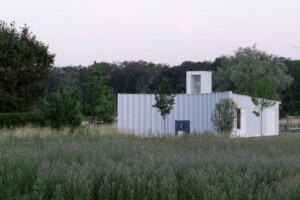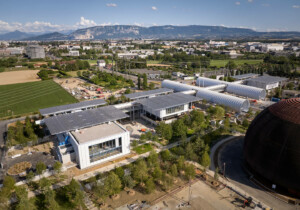The Swiss Institute for Contemporary Art has opened its new 7,500 square foot Selldorf Architects-designed location on St. Marks Place in New York City. Taking over four levels of a former bank built in 1954 and designed by Alfred Hopkins and Associates, the renovation is, in the words of Swiss Institute director Simon Castets, a “counter narrative” to the building’s former financial, low-occupancy use.
The Selldorf redesign uses a seemingly minimal touch. Though there have been significant changes—full stairwells and elevators have been added along with a total plan rework—the overall architectural sensibility feels light and unimposing. White walls remain unadorned. Flooring is understated. On all ceilings, ductwork, lighting, and structural elements remain exposed—a departure from many recent galleries in the city that have instead focused on hiding every functional detail, even the lighting, as much as possible.
Curators generally aren’t keen on losing space to the workaday trappings of administrative necessity. Swiss Institute has filled every corner, wall, stairwell, and even the elevator with art to allow “artists to reclaim the space lost to New York City building code” as part of the SI ONSITE program. Stairwells feature sculptures and frescoes by Shahryar Nashat and Latifa Echakhch. The elevator has been turned into an artwork, skinned in a welcoming pink from Sherwin Williams called “Memorable Rose,” which is taken from the color of a tongue by artist Pamela Rosenkranz for an installation appropriately titled Color of a Tongue (Director) (2018). A cellar gallery remains honest about what it really is with layers of gray paint applied by Dusty Baker.
Like the building itself, the current exhibition, Readymades Belong to Everyone (open through August 19), is packed with art. The first floor, which features ceilings that soar over 17 feet, is dense with all variety of sculpture and 2D work. Despite lower ceilings, the new location’s upper level is airy, wrapped in windows with exposed wood shining on the ceiling. There is a reading room, currently taken over by a project from Heman Chong in collaboration with Ken Liu. Chong and Liu’s Legal Books (Shanghai) features hundreds of books selected by Liu, a sci-fi writer and attorney, inspired by thinking on the Chinese legal system. The art instillation-cum-reading room features painted curtains by Jill Mulleady, another way in which the Institute is packing in the art.
https://www.instagram.com/p/BkVg-UtlioO/?taken-at=5122362
One enters from Second Avenue to find a visitor welcome desk and a bookshop from Printed Matter. The entire space is decked out in the clean lines of USM’s furniture, and behind the visitor information desk is John Armleder’s Royal Flush (2018) installation of mirrored tiles reminiscent of a disco ball.
https://www.instagram.com/p/BkYmINDnsN8/?taken-at=5122362
The Swiss Institute also takes the art outdoors with a terrace that places visitors in the midst of the city. The current plein air setup includes work by Valentin Carron, Nancy Lupo, and Michael Wang. In Wang’s Extinct in the Wild series, the artist references Peter Stuyvesant’s original orchard, composed of native plants that now only grow with human care and populated what is now the East Village.
Signage on the building is multilingual, not merely with the four official languages of Switzerland, but also with the most spoken languages in the Swiss Institute’s new surrounding area: English, Spanish, and Chinese. The Swiss Institute, which has free admission, has also been collaborating with local community organizations for artist-led workshops and is actively celebrating the artistic history and present of their new East Village location.
The Swiss Institute’s new 38 St. Marks location opens with the exhibition Readymades Belong to Everyone, on view now, curated by Fredi Fischli and Niels Olsen. In addition to the artists described above, the show features many architects and designers including OFFICE, Rem Koolhaas, MOS Architects, and Sauter von Moos in collaboration with Herzog and de Meuron.











